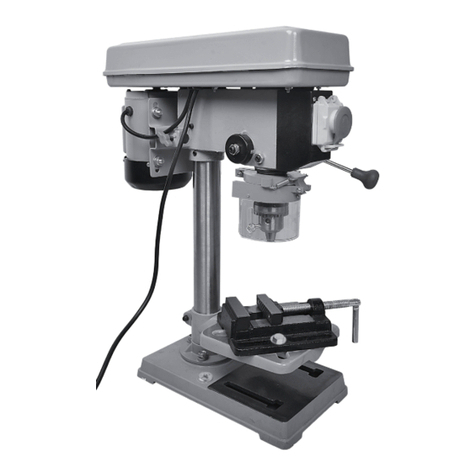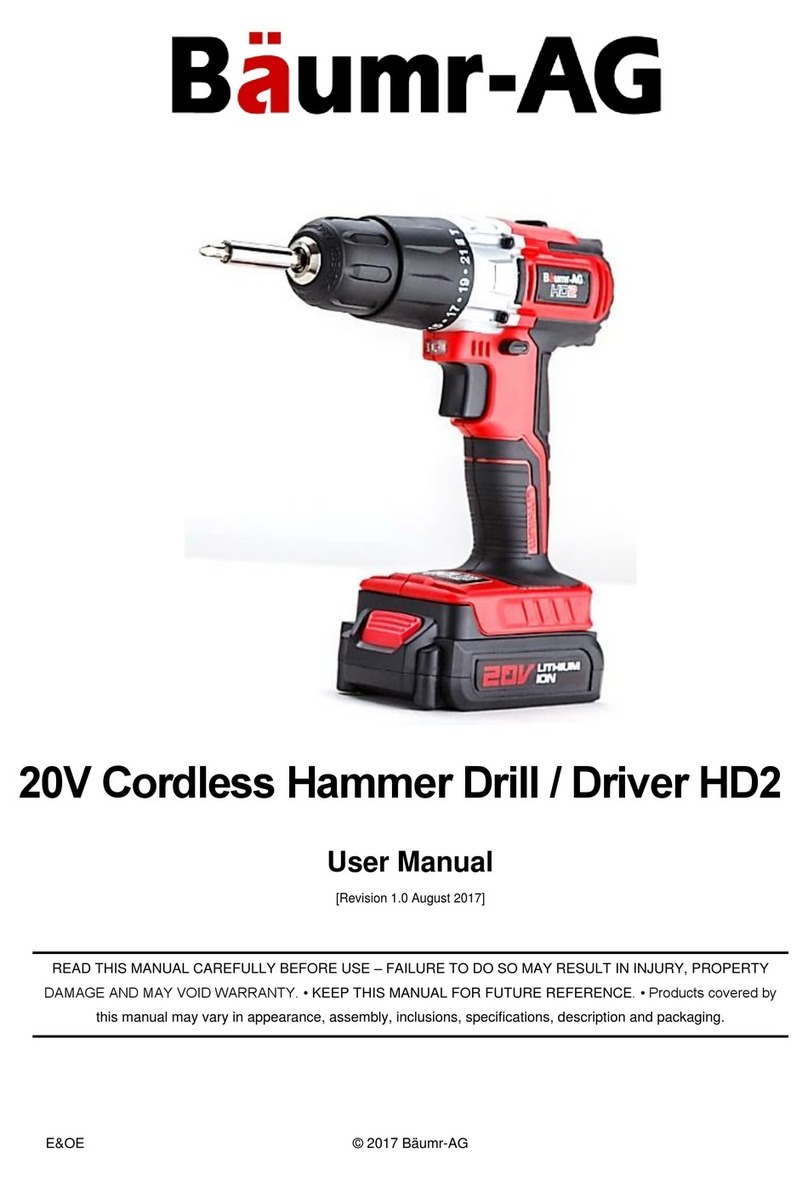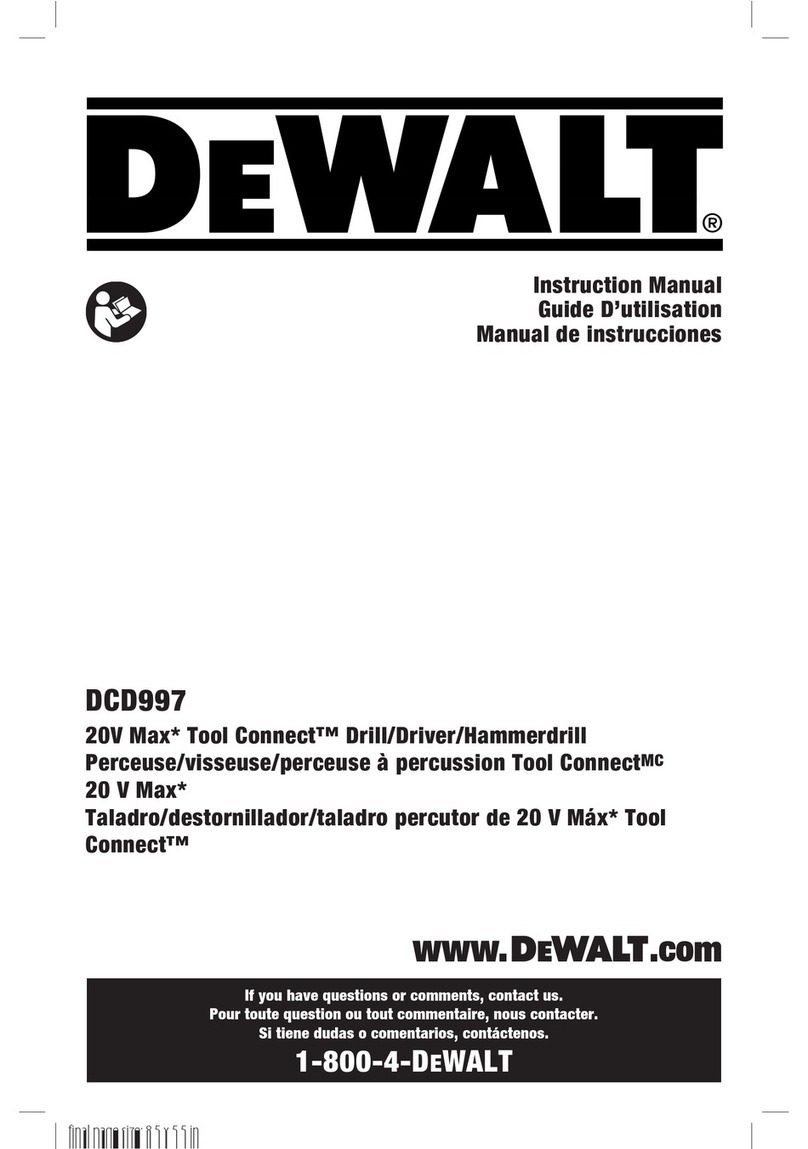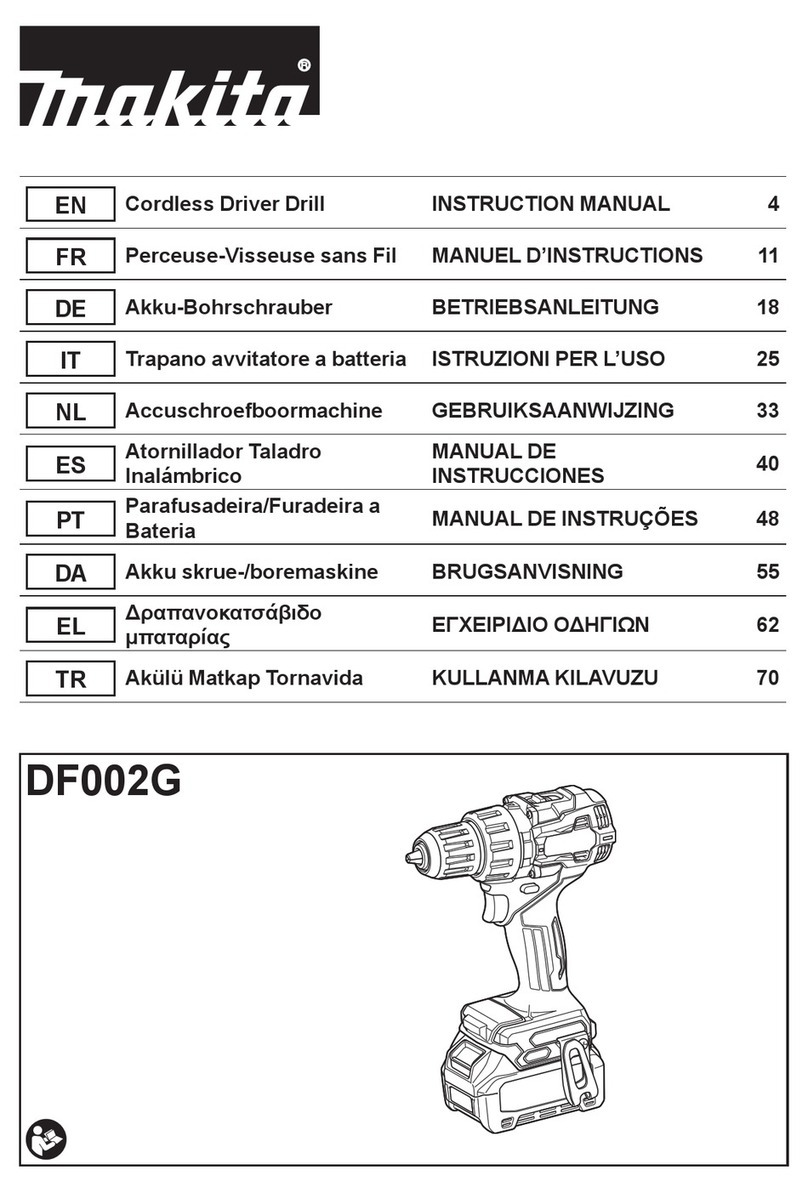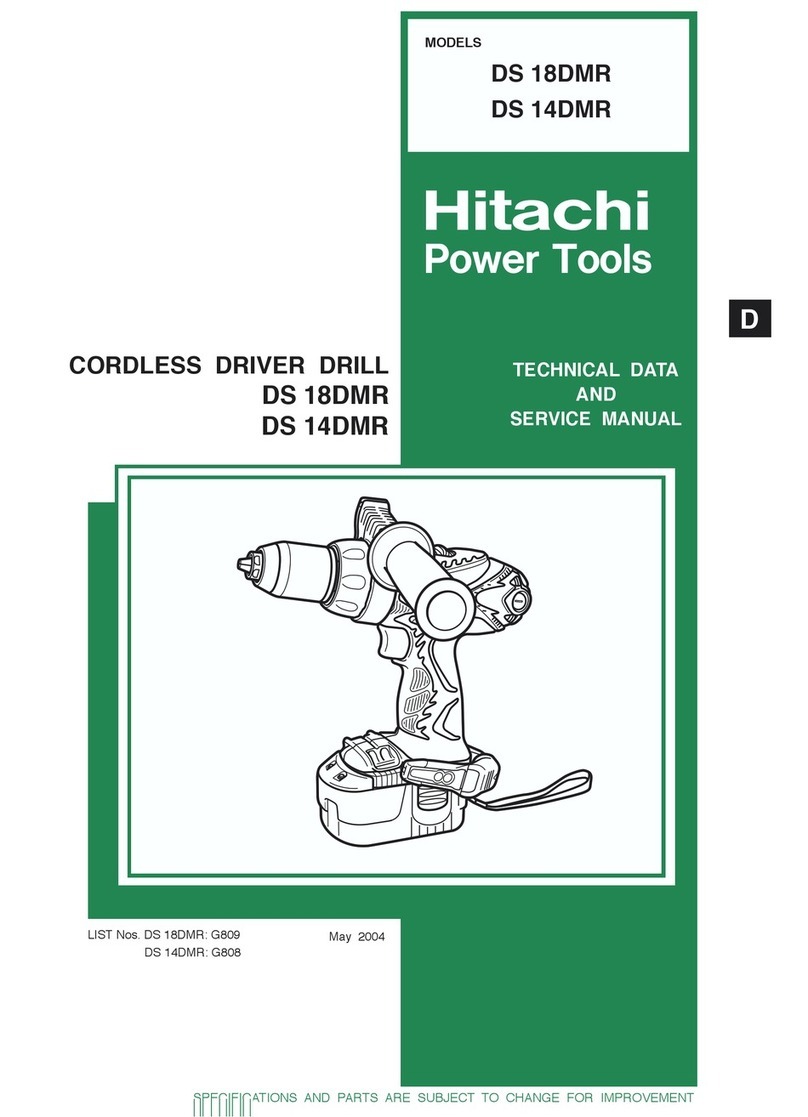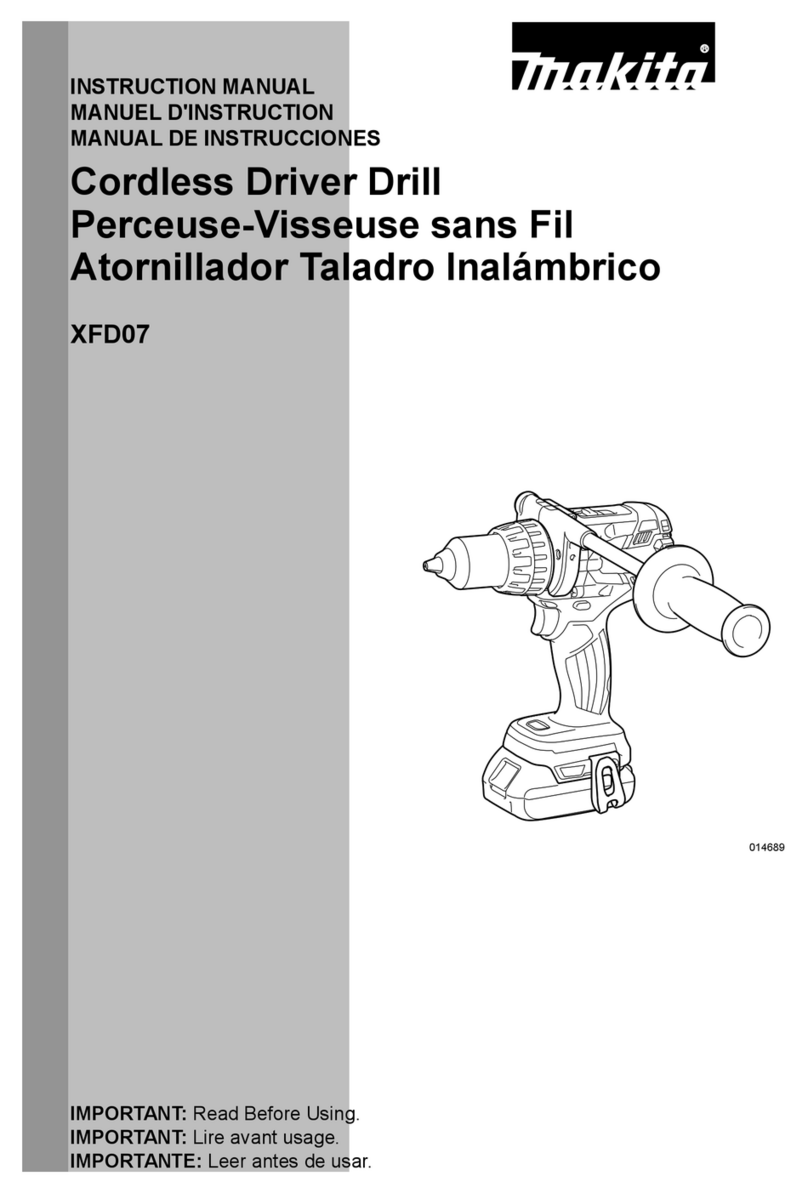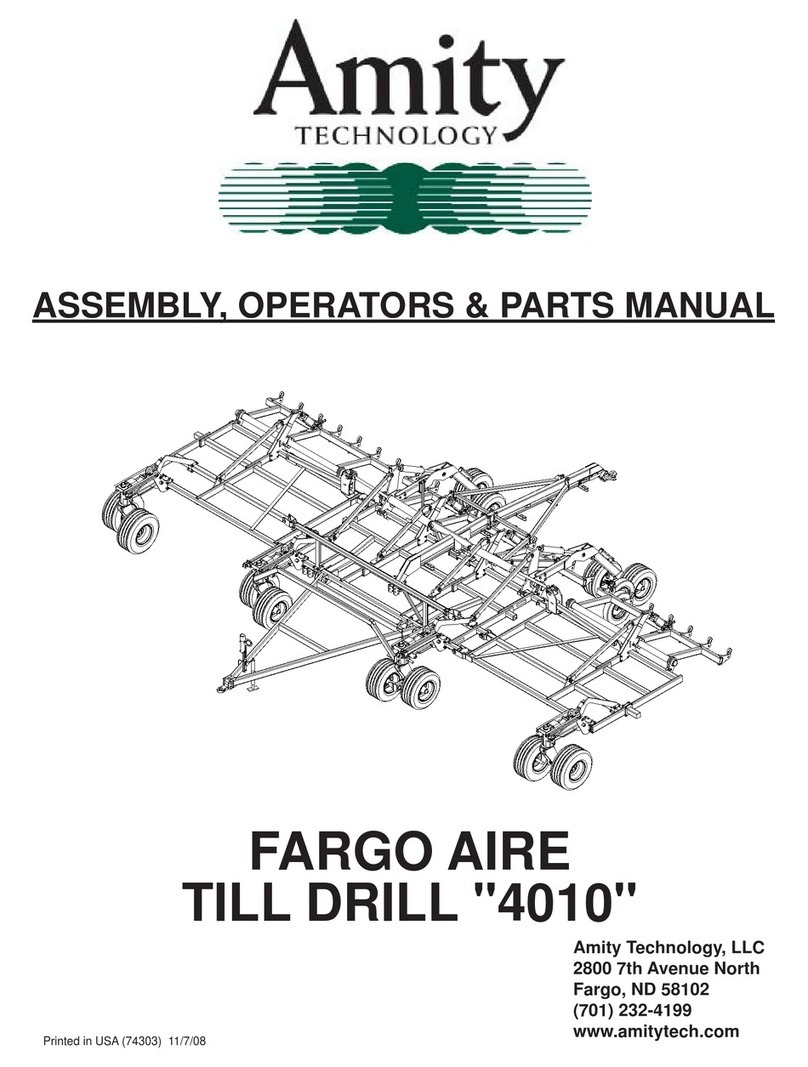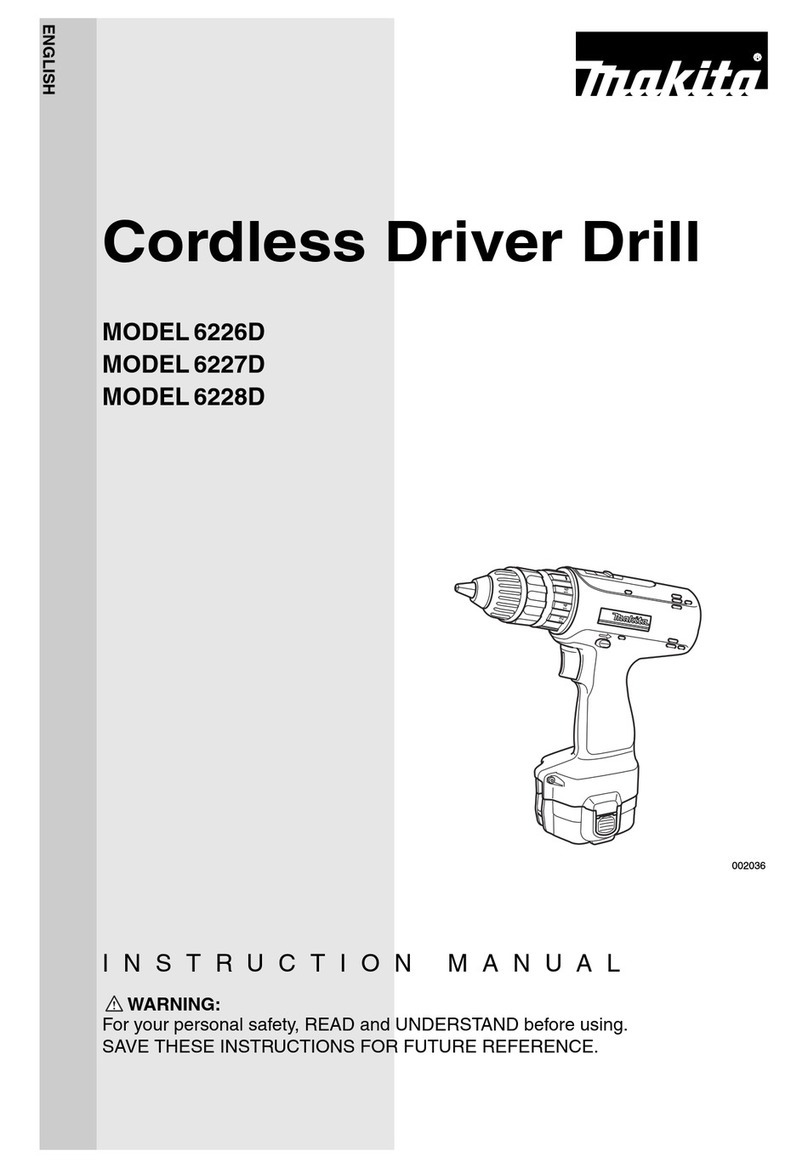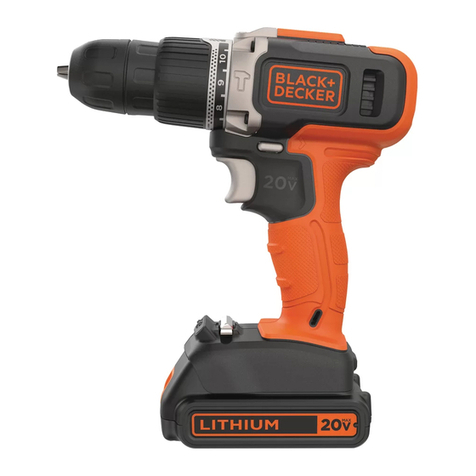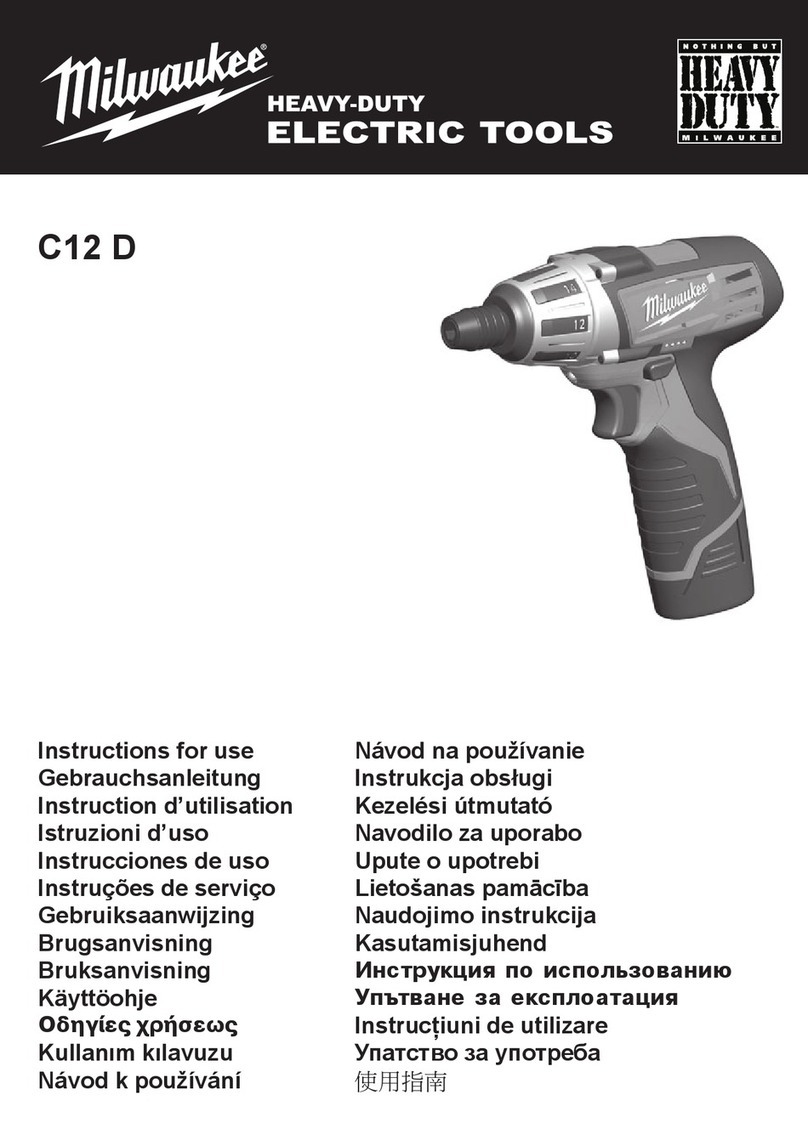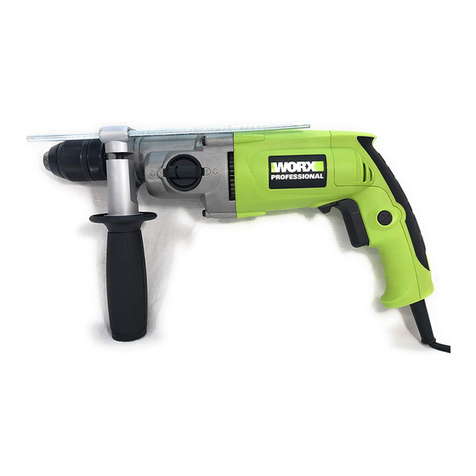Enco 31 User manual

MILLING \ DRILLING MACHINE
MODEL 31(BS) / 31N2F(BS) / 25
INSTRUCTION MANUAL
31-100827-R4
All manuals and user guides at all-guides.com
all-guides.com

WARNING
!!
Some dust created by power sanding, sawing,
grinding, drilling, and other construction activities
contains chemicals known to the State of California to
causecancer,birth defects or other reprodrctive harm.
Someexamples of these chemical are:
‧Lead from lead-based paints.
‧Crystalline silica from bricks, cement and other
masonry products.
‧Arsenic and chromium from chemically-treated
lumber.
Yourriskfrom these exposures varies, depending on
how often you do this type of work. To reduce your
exposure to these chemicals: Work in a well ventilated
area,andwordwith approved safety equipment, such
asthosedust masks that are specially designed to
filter out microscopic particles.
All manuals and user guides at all-guides.com

- -
1
TableOfContents PageNo
1 Overall Aspect ………………………………………………………………… 2
2 Safety Rules For tools ………………………………………………………… 3
3 Specification …………………………………………………………………… 5
4 Features ……………………………………………………………………..… 6
5 Delivery & Installation …………………………………………………….. 6
6 Minimum Room Space For Machine Operation …………………………… 8
7 Use Of Main Machine Parts ……………………………………………….… 8
8 Precaution For Operation …………………………………………………… 9
9 Adjusting Table Slack And Compensate For Wear ………………………. 10
10 Clamping /Table Base And Machine Base …………………………………. 11
11 Speed Changing And Adjust Belt …………………………………………… 11
12 To Change Tools ……………………………………………………………… 12
13 Ordering Replacement Parts …………………………………………………12
14 Extra Tooling And Accessories ……………………………………………. .. 12
15 Tapping Equipment ………………………………………………………….. 13
16 Spindle Power Down Feed Operation …..…………………………………... 13
17 Specification Of T Slot ……………………………………………………….. 14
18 Maintaining ……………………………………………………………….….. 14
19 Cleaning & Lubricating …………….……………………………………… 14
20 Trouble Shooting ……………………………………………………………... 15
21 Circuit Diagram ……………………….……………………………………… 18
22 Parts Lists …………………………………………………………………… 21
All manuals and user guides at all-guides.com

- -
2
Overall Aspect
All manuals and user guides at all-guides.com

- -
3
WARNING: FAILURE TO FOLLOW THESE RULES
MAY RESULT IN SERIOUS PERSONAL INJURY
As with all machinery there are certain hazards involved with operation and use of the machine.
Using the machine with respect and caution will considerably lessen the possibility of personal
injury. However, if normal safety precautions are overlooked or ignored, personal injury to the
operator may result.
This machine was designed for certain applications only. We strongly recommends that this
machine NOT be modified and/or used for any application other than for which it was designed. If
you have any questions relative to its application DO NOT use the machine until you contact with
us and we have advised you.
Your machine might not come with a power socket or plug. Before using this machine, please
Do ask your local dealer to install the socket or plug on the power cable end.
SAFETY RULES FOR ALL TOOLS
A. USER:
1. WEAR PROPER APPAREL. No loose clothing, gloves, rings, bracelets, or other jewelry to
get caught in moving parts.
Non-slip foot wear is recommended. Wear protective hair covering to contain long hair.
2. ALWAYS WEAR EYE PROTECTION. Refer to ANSLZ87.1 standard for appropriate
recommendations.
Also use face or dust mask if cutting operation is dusty.
3. DON'T OVERREACH. Keep proper footing and balance at all times.
4. NEVER STAND ON TOOL. Serious injury could occur if the tool is tipped or if the cutting
tool is accidentally contacted.
5.NEVER LEAVE TOOL RUNNING UNATTENDED. TURN POWER OFF. Don't leave
tool until it comes to a complete stop.
6. DRUGS, ALCOHOL, MEDICATION. Do not operate tool while under the influence of drug,
alcohol or any medication.
B. USE OF MACHINE:
1. DON'T FORCE TOOL. It will do the job better and be safer at the rate for which it was
designed.
2. USE RIGHT TOOL. Don't force tool or attachment to do a job for which it was not designed.
3. SECURE WORK. Use clamps or a vise to hold work when practical. It's safer than using your
All manuals and user guides at all-guides.com

- -
4
hand frees both hands to operate tool.
4. USE RECOMMENDED ACCESSORIES. Consult the owner's manual for recommended
accessories. The use of improper accessories may cause hazards.
5. AVOID ACCIDENTAL STARTING. Make sure switch is in “OFF” position before
plugging in power cord.
C. ADJUSTMENT :
MAKE all adjustments with the power off. In order to obtain the machine. precision and correct
ways of adjustment while assembling, the user should read the detailed instruction in this manual.
D. WORKING ENVIRONMENT:
1. KEEP WORK AREA CLEAN. Cluttered areas and benches invite accidents.
2. DON'T USE IN DANGEROUS ENVIRONMENT. Don't use power tools in damp or wet
locations, or expose them to rain. Keep work area well-lighted.
3. KEEP CHILEREN AND VISITIORS AWAY. All children and visitors should be kept a safe
distance from work area.
4. DON’T install & use this machine in explosive, dangerous environment.
E. MAINTENANCE
1. DISCONNECT machine from power source when making repairs.
2. CHECK DAMAGED PARTS. To read every details of trouble shooting, repair it very
carefully and make sure the operator won't get injure and damage the machine.
Thank you for purchasing the 31 MILLING/GRILLING Machine. If properly cared for and
operated, this machine can provide you with years of accurate service. Please read this manual
carefully before using your machine.
All manuals and user guides at all-guides.com
all-guides.com

- -
5
1.SPECIFICATION
MODEL 31(BS) / 31N2F(BS) 25
Drilling capacity 32mm(11/4") 25 mm (1")
Face mill capacity 76mm(3") 64 mm (2-1/2")
End mill capacity 20mm(3/4") 13mm (1/2")
Spindle nose to column surface 170mm(6-3/4") 170mm(6-3/4")
Max. distance spindle nose to table 430mm(16-7/8") 325 mm(12-3/4")
Spindle tape
r
M.T.3 R-8 M.T.3 R-8
Spindle stroke 130mm(5-1/8")(N2F=107mm)90 mm (3-1/2")
Diameter of Spindle sleeve 75mm(3") 62 mm (2-7/16")
Head swivel 360∘360∘
Diameter of column 115mm(4-1/2") 92 mm (3-5/8")
Overall height (w/o stand) 1240mm(48-7/8") 1050 mm (41-3/8")
Length 990mm(39") 910mm(35-7/8")
Width 1100mm(43-3/8") 960mm(37-7/8")
M
achine stand height 715mm(28-1/8") 715mm(28-1/8")
Moto
r
1-1/2HP - 2HP 3/4HP – 1HP
50Hz 125-2500 90-2150Spindle spee
d
( r.p.m.) 12S 60Hz 150-3000 110-2580
Standard accessories 3"-cutter 1/2" chuck 3 " angle
vise
2 1/2" –cutter 1/2" chuck
3" angle vise
Forward and backward travel of
table 185mm(7-1/4") 150 mm (5-7/8")
Right and left travel of table 430mm(16-7/8") 340 mm (13-3/8")
Working area of table 730mm x 210mm(283/4"x 81/4") 585mm x 190mm(23"x 71/2")
Gross weight 300kgs (660 lbs) 200kgs (440 lbs)
Measurement 20’Container Q’ty: 42 sets 20’Container Q’ty: 48 sets
Extra accessories Power down (spindle) feed
Tapping switch
Forward & Reverse switch
Collet chuck
Work light
Cabinet stand
Extension
column Clamping kits
Forward & Reverse switch
Collet chuck
Work light
Cabinet stand
Clamping kits
Noise 80 dB MAX 80 dB MAX
All manuals and user guides at all-guides.com

- -
6
Tools selection & proper material range
Tool type Tool material Work piece material
HSS Non-iron material steel iron
End mill
TUNGSTEN CARBIDE Cast iron non-iron material
Face mill TUNGSTEN CARBIDE Non-iron material steel iron
Light material
Drilling HSS Non-iron material steel iron
Light material
Tapping HSS Non-iron material steel iron
Light material
2. FEATURES
(1) This machine has, several uses, such as surface cutting, drilling, milling, and also can be
equipped with an electric switch for tapping.
(2) This machine is of fine quality, can be operated easily, and it is not limited to skilled operators.
(3) The drilling and milling operation can be performed by two methods:
1). Hand operation, which makes quick drilling.
2). Worm gear feed operation, which makes slow milling.
(4) Bronze adjustable nuts, which adjust the thread clearance and reduce the wear. They also make
screws rotated smoothly and increase the thread accuracy.
(5) Whole column which makes this machine strong, stable, and also keep the high accuracy.
(6) Head of tough cast ensures its accuracy lasting and enduring through the treatment of precise
boring cylinder, grinding, and internal stress relief.
(7) To adjust belt and change speed, new pulley cover is easy to open the cover.
3. DELIVERY & INSTALLATION
Unpacking
1. Transportation to desired location before unpacking, please use lifting jack.(Fig. B)
2. Transportation after unpacking, please use heavy duty fiber belt to lift up the machine.
ALLWAYS KEEP PROPER FOOTING & BALANCE WHILE MOVING THIS MACHINE.
All manuals and user guides at all-guides.com

- -
7
Fig. B
Installation:
(1) BE SURE all locks of head-stock & column are tighten before operation.
(2) ALWAYS Keep proper footing & balance while moving this 300kgs machine. And only use
heavy duty fiber belt to lift the machine as per Fig. A.
(3) KEEP machine always out from sun, dust, wet, raining area.
(4) POSITION & tighten 4 bolts into base holes properly after
machine in balance.
(5) TURN OFF the power before wiring & be sure machine in
proper grounding. Overload & circuit breaker is recommended for
safety wiring.
(6) CHECK carefully if main shaft in clockwise direction while
running test. If not, reverse the wiring then, repeat the test till
spindle direction is correct.
(7) Finish removing this wooden case/crate from the machine.
Unbolt the machine from the crate bottom.
(8) Carefully lift the machine to a sturdy stand or work bench. For best performance, through bolt
the machine to bench or stand.
(9) Bolt the stand legs to the floor, while using a sturdy stand.
Before Bolting The Machine To A Bench Or Stand Or Floor, The Unit Must Be Level In Both
Directions.
All manuals and user guides at all-guides.com

- -
8
4. MINIMUM ROOM SPACE FOR MACHINE OPERATION
For31/31N2F For25
5. USE OF MAIN MACHINE PARTS (See Fig. l)
(1) To raise and lower the head by head handle.
(2) Equipped with an electric switch for tapping operation clockwise or counterclockwise.
(3) To adjust the quick or slow feeding by feed handle.
(4) To adjust the table left and right travel by table handle wheel.
(5) To adjust the table fore and aft travel by table handle wheel.
(6) To operate the spindle handle wheel for micro feed.
(7) To adjust the scale size according to working need.
(8) Switch button function description.
(a) Before starting the machine turn the selection
knob (A) to (right for clock wise running, left
for counter clock vise)
(b) Push button (C) to start the machine.
(c) Push button (B) to stop the machine.
(d) When in emergency push button to stop the
machine. after clearing the trouble, release
emergency button, re-start the machine by
pushing the start button.
All manuals and user guides at all-guides.com

- -
9
6. PRECAUTION FOR OPERATION
Check all parts for proper condition before operation; if normal safety precautions are notice
carefully, this machine can provide you withstanding of accurate service.
(1) Before Operation
(a) Fill the lubricant.
(b) In order to keep the accurate precision, the table must be free from dust and oil deposits.
(c) Check to see that the tools are correctly set and the work-piece is set firmly.
(d) Be sure the speed is not set too fast.
(e) Be sure everything is ready before use.
(2) After Operation
(a) Turn off the electric switch.
(b) Turn down the tools.
(c) Clean the machine and coat it with lubricant.
(d) Cover the machine with cloth to keep out the dust.
(3) Adjustment of Head
(a) To raise and lower the head, loosen the two heavy duty head lock nuts shown in Fig.l. Use the
left side head handle to raise and lower the head on its rack and pinion mechanism. When the
desired height is reached, tighten the bolts to avoid vibration.
(b) Head may be rotated 360∘by loosening the same bolts mentioned above. Adjust the head to
the desired angle, then fix the heavy duty head lock-nuts. It is tighten the same time to fix the
head if drilling & milling too much.
(4) Preparing for Drilling (see fig. 2)(Except addition power feed system).
Turn of the knob make loose the taper body of worm gear and spring base. Then we decide
spindle stroke setting the positive depth stop gauge for drilling blind hole or free state for pass
hole.
(5) Preparing for Milling (see fig. 2)(Except addition power feed system).
(a) Adjust the positive depth stop gauge to highest point position.
(b) Turn tight of the knob be use to taper friction force coupling the worm gear and spring base.
Then turning the handle wheel by micro set the spindle of work piece machining height.
(c) Lock the rack sleeve at the desired height with fixed bolt.
All manuals and user guides at all-guides.com
all-guides.com

- -
10
QUILL RETURN SPRING ADJUSTMENT:
Spring tension for return of spindle, after hole drilling, has been pre-set at the factory. No fur-
ther adjustment should be attempted unless absolutely necessary. Adjustment will probably be
required if a multiple drilling or tapping head is used. If adjustment is necessary, loosen lock screw
while holding. Do not allow the housing to turn in your hand, or spring will unwind. Turn entire
housing assembly clockwise the number of turns necessary to cause the quill to return to its up
position. (NOTE. The flat of the spring housing pilot is lined up with the spring loading hole on the
body of the spring housing.) Reset lockscrew make sure point of screw mates to flat on the housing
journal.
7. ADJUSTING TABLE SLACK AND COMPENSATE FOR WEAR (see Fig. 3)
(1) Your machine is equipped with Jib strip adjustment to compensate for wear and excess slack
on cross and longitudinal travel.
(2) Clockwise rotation the job strip bolt with a big screw for excess slack otherwise a little counter
clockwise if too tight.
(3) Adjust the jib strip bolt until feel a slight drag when shifting the table.
All manuals and user guides at all-guides.com

- -
11
8. CLAMPING, TABLE BASE, AND MACHINE BASE (see Fig. 3)
(1) When milling longitudinal feed, it is advisable to lock the cross feed table travel to insure the
accuracy of your work. To do this, tighten the small leaf screw located on the right side of the
table base.
(2) To tighten the longitudinal feed travel of the table for cross feed milling, tighten the two small
leaf screw on the front of the table base
(3) Adjustable travel stops are provided on the front of the table for control of cross travel and the
desired milling length.
9. SPEED CHANGING AND ADJUST BELT (Step See Fig. 4)
(1) Turn power off.
(2) Open belt cover by releasing side latches step see(a)(b)(c).
(3) Loosen motor mount leaf screw.
(4) Push motor in order to loosen belts(head side of motor mount is set fixed, two motor's ear side
with motor screw to tighten or loosen of belts.)
(5) Loosen two screws for base of speed change inter pulley that also adjust the location of base for
speed change inter pulley.
(6) Select the suitable R.P.M. from speed charts of table 1. Then place the belts on the desired
pulley steps.
(7) Tighten two screws of base for speed change pulley and the bolt of motor mount lock.
(8) Cover the belt cover before turnning power on.
All manuals and user guides at all-guides.com

- -
12
12 SPEEDS 12 SPEEDS
50Hz 60Hz
BELT
50Hz 60Hz
BELT
125 150 4-5 710 850 1-6
185 225 3-5 1000 1200 2-7
210 255 4-6 1250 1500 3-8
300 350 2-5 1350 1600 1-7
350 400 3-6 1900 2300 2-8
420 500 4-7 2500 3000 1-8
Table .1 For 31/31N2F
For25
10. TO CHANGE TOOLS
(1) Removing Face Mill or Drill Chuck Arbor
Loosen the arbor bolt (see fig. 4) at the top of the spindle shaft approximately 2 turns with a
wrench. Rap the top of the arbor bolt with a mallet. After taper has been broken loose, holding
chuck arbor on hand and turn detach the arbor bolt with the other hand.
(2) To Install Face Mill or Cutter Arbor
Insert cutter and cutter arbor into the taper of spindle. Tighten arbor bolt detach securely, but do
not over-tighten.
(3) Removing Taper Drills
(a) Turn down the arbor bolt and insert the taper drill into the spindle shaft.
(b) Turn the rapid down handle rod down until the oblong hole in the rack sleeve appears.
Line up this hole with the hole in the spindle. Insert key punch key through holes and strike
lightly with a mallet. This will force the taper drill out.
11. ORDERING REPLACEMENT PARTS
Complete parts list is attached. If parts are needed, contact your local distributor.
12. EXTRA TOOLING AND ACCESSORIES
Each of machines is equipped with a MT # 3 spindle taper or a R-8 spindle taper (examples below).
Contact your local distributor or a major cutting tool distributor to obtain any of these accessories.
Taper Drills
Reamers
All manuals and user guides at all-guides.com

- -
13
End Mills
Cutter Arbor
Taps
Collets
Adapters and Sleeves
13. TAPPING EQUIPMENT
This machine can be equipped with an electric switch for tapping operation clockwise or
counter-clockwise, and the working depth also can be adjusted by the limit switch. (Electric switch
will be installed according to your requirement, and you must pay the cost only.)
14. SPINDLE POWER DOWN FEED OPERATION
1. Select profitable spindle speed and automatic feeding rate according to cutting condition.
By adjusting the shift dial A you can obtain the feed rate you need.
2. FEEDING DEPTH SETTING:
First release the dial fix-nut E and turn the indicating ring C to the depth needed. then reset
E tightly again.
CAUTION: DO NOT LET FEEDING DEPTH EXCEEDED SPINDLE STROKE.
3. START FEEDING
Start the machine and push out the handle rod D, then the spindle will feed down automatically
Until the end of stroke you set.
4. END OF AUTO FEEDING
The spindle will return to top when reaching the end of stroke you set. when in emergency or
Desire to stop the motion during feeding, push back the handle rod D to its original place.
5. MICRO FEEDING BY MANUAL
Set the shift dial A to "0" postion, and start feeding by turning F handle.
6. To prevent danger, when spindle power down feed is not in use, please lock the handle B well.
All manuals and user guides at all-guides.com

- -
14
15. SPECIFICATION OF T-SOLT
The size of T-Solt on table as Fig 6:
For31/31N2F For25
16. MAINTAINING
That's easier to keep machine in good condition or best performance by means of maintaining it at
any time than remedy it after it is out of order.
(1) Daily Maintenance (by operator)
(a) Fill the lubricant before starting machine everyday.
(b) If the temperature of spindle caused over-heating or strange noise, stop machine immediately
to cheek it for keeping accurate performance.
(c) Keep work area clean; release vise, cutter, work-piece from table; switch off power source;
take chip or dust away from machine and follow instructions lubrication or coating rust proof
oil before leaving.
(2) Weekly Maintenance
(a) Clean and coat the cross leading screw with oil.
(b) Check to see if sliding surface and turning parts lack of lubricant. If the lubricant is
insufficant, fill it.
(3) Monthly Maintenance
(a) Adjust the accurate gap of slide both on cross and longitudinal feed.
(b) Lubricate bearing, worm, and worm shaft to avoid wear.
(4) Yearly Maintenance
(a) Adjust table to horizontal position for maintenance of accuracy.
(b) Check electric cord, plugs, switches at least once a year to avoid loosening or wearing.
17. CLEANING & LUBRICATING
(1) Your machine has been coated with a heavy grease to protect it in shipping. This coating should
be completely removed before operating the machine. Commercial degreaser, kerosene or
similar solvent may be used to remove the grease from the machine, but avoid getting solvent
All manuals and user guides at all-guides.com
all-guides.com

- -
15
on belts or other rubber parts.
(2) After cleaning, coat all possible rusted surface with a light lubricant. Lubricate all points in
Fig.1. with a medium consistency machine oil.
(4) Lubricating points as shown in arrows.
18. TROUBLE SHOOTING
(1) No running after switch on:
(a) Main switch interruption while volts irregular - Adjust input voltage and draw back the main
switch.
(b) Break down of fuse in switch box - Replace with new one.
(c) In case of too much current, the overload relay jumps away automatically - Press the overload
relay, and it will return to the correct position.
(2) Motor Overheat and No Power:
(a) Overload - Decrease the load of feed.
(b) Lower voltage - Adjust to accurate voltage.
(c) Spoiled contact point of magnetic switch - Replace with new one.
(d) Breakdown of overload relay - Connect it or replace with new one.
(e) Motor is poor - Replace with new one.
(f) Break down of fuse or poor contact with wire (it is easily, to spoil motor while short circuit)
Switch off power source at once and replace fuse with new one.
(g) The tension of pulley V-belt too tight - Adjust for proper tension of V-belt.
(h) If this machine with the tapping attachment, there is an aid plum screw fix on the motor
mount in order to avoid the motor pulleys shake while turning.
(3) The temperature of spindle bearing is too hot:
(a) Grease is insufficient - Fill the grease.
(b) The spindle beating is fixed too tight - turning with no speed and feel the tightness with hand.
(c) Turning with high speed for a long time - Turn it to lightly cutting.
(4) Lack of power with main spindle revolving:
(a) The tension of V-belt too loose - Adjust far proper tension of V-belt.
(b) Motor has burned out - Change a new motor.
(c) Fuse has burned out - Replace with new one.
(5) Table travel has not balanced:
(a) The gap of spindle taper too wide - Adjust bolt in proper.
(b) Loosening of leaf bolt - Turn and fasten in place.
(c) Feed too deep -Decrease depth of feed.
(6) Shake of spindle and roughness of working surface has taken place during performance:
(a) The gap of spindle bearing too wide - Adjust the gap in proper or replace bearing with new
one.
All manuals and user guides at all-guides.com

- -
16
(b) Spindle loosening up and down - Make two of inner bearing covers on the top tight each
other. Do not over-tighten two inner bearing covers with the taper bearing; it is ok as long as
no gap between them.
(c) The gap of taper sliding locate too wide - Adjust the tension of bolt in proper.
(d) Loosening of chuck - Fasten chuck.
(e) Cutter is dull – Re-sharpen it.
(f) Work-piece has not hold firmly - Be sure to tighten work-piece.
(7) Micro feed does not work smoothly:
(a) Loosening of clutch - Be sure to tighten it.
(b) Worm and worm shaft has worried out - Replace with new one.
(c) Loosening of hand-wheel fixed screw - Be sure to tighten it.
(8) Without accuracy in performance:
(a) The balance of the work-piece - must be considerate as the principle balance while holding
work-piece.
(b) Often use of hammer to strike work-piece - Forbidden to use hammer to strike work-piece.
(c) Unaccurate horizontal table - Cheek and maintain table for keeping accurate horizontal after a
period of use.
(9) Excessive vibration:
(a) Motor out-of-balance. – Balance or replace problem motor.
(b) Bad motor. – Replace motor.
(10) Motor stalls:
(a) Over feeding - Reduce feed rate.
(b) Dull drill – Sharpen drill and keep sharp.
(c) Motor not building up to running speed. – Replace or repair motor. Check fuses in all three
legs on three phase motors and replace if necessary.
(d) Bad motor. – Replace motor.
(11) Noisy operation:
(a) Excessive vibration. – Check remedy under excessive vibration.
(b) Improper quill adjustment. – Adjust quill.
(c) Noisy spindle. – Lubricate spindle.
(d) Noisy motor. – Check motor bearings or for loose motor fan.
(12) Drill or Tool heats up or burns work:
(a) Excessive speed. – Reduce speed.
(b) Chips not clearing. – Use pecking operation to clear chips.
(c) Dull tool. – Sharpen tool or replace.
(d) Feed rate too slow. – Increase feed enough to clear chips.
(e) Rotation of frill incorrect. – Reverse motor rotation.
(f) Failure to use cutting oil or coolant (on steel). – Use cutting oil or coolant on steel.
All manuals and user guides at all-guides.com

- -
17
(13) Drill leads off:
(a) No drill spot. – Center punch or center drill work-piece.
(b)Cutting lips on drill off center. – Regrind drill.
(c) Quill loose in head. – Tighten quill.
(d)Bearing play. – Check bearings and reseat or replace if necessary.
(14) Excessive drill run-out or wobble:
(a) Bent drill. – Replace drill. Do not attempt to straighten.
(b)Bearing play. – Replace or reseat bearings.
(c) Drill not seated properly in chucks. – Loosen, reseat and tighten chuck.
(15) Work or fixture comes loose or spins:
Failure to clamp work-piece or work holding device to table. – Clamp work-piece or work
holding device to table surface.
All manuals and user guides at all-guides.com

- -
18
CIRCUIT DIAGRAM
All manuals and user guides at all-guides.com
This manual suits for next models
4
Table of contents
Other Enco Drill manuals


